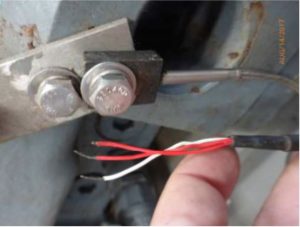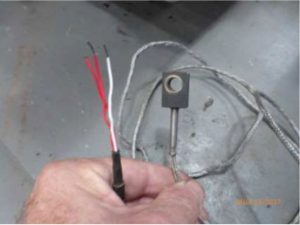Vincent started building vapor-tight presses in the 1980’s. These are used in applications which are potentially explosive because solvent (normally aqueous alcohol) is being expelled from organic material. Ten years ago our designs were certified to the European ATEX standard. This led to the use of RTD’s (Resistance Temperature Detectors) on vapor-tight presses.
Most RTD’s we use are surface mount units, as shown in the photo below. These usually have in them a thin film chip sensor, although some have a thermocouple made with two wires of dissimilar metals joined together. There is an eyelet at the end. This eyelet is attached to a bolt or a stud at the point at which temperature is to be sensed.
The other end of the RTD goes to a 4-20 milliamp transmitter which sends the temperature signal to the control panel. The client runs wiring from the transmitter to their control system.
Both the RTD’s and transmitters must be ATEX certified. We have been buying them from JUMO GmbH and Endress + Hauser.
For example a Vincent twin screw press has twelve Resistance Temperature Detectors. There will be one mounted near the (high speed) input shaft of the gearbox plus one on the oil sump of the gearbox. There is one each on four shaft bearings which support the two screws. There is one on each shaft seal housing. In addition, there are four more, one each covering the bushings of the discharge cone.
The gearbox and bearing RTD’s are in ATEX Zone 2. However the cone bushing RTD’s are in ATEX Zone 1. To avoid any mix-up, all the RTD’s we use are rated for Zone 1.
The normal operating temperatures of the monitored points is not known until the machinery is placed in service. The procedure we have used for setting controls has been to observe normal operating temperatures. Then alarm points are set 5C to 10C over those temperatures. Trip points are set another 5C to 10C over that.
We do not install RTD’s on the drive motor because these XP motors come with internal thermistors. Unlike RTD’s, thermistors are made of a material which changes resistance with temperature. Typically two are mounted on the windings of the motor, one for temperature alarm and one for shut-down. The wires from these are found in the junction box, and the customer wires them into his control system and motor control center. When thermistors cool down, their resistance returns to normal, allowing the motor to be re-started.


Originally published August 17, 2017
Updated August, 2018
